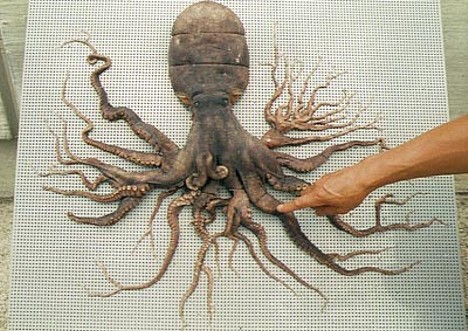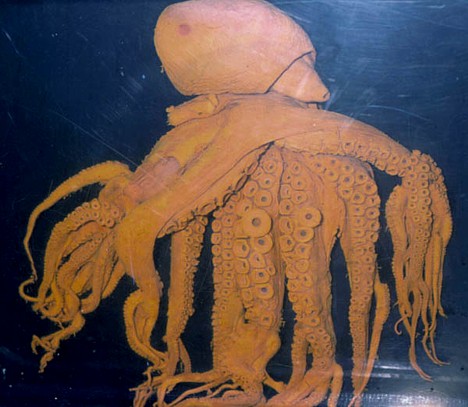Tentacles
Posted by: Loren Coleman on January 25th, 2009

The 1998 octopus / Matoya Bay.
It is very rare in nature to find octopuses with extra tentacles, but in December 1998, a common octopus was captured in Matoya Bay, Japan, which had a whopping 96 tentacles.
The unusual octopus had the normal 8 appendages attached to the body, but each one of those branched out to form the extra tentacles. The specimen survived for five months after its capture, and even laid eggs, which hatched into normal 8 tentacled octopi. Upon its death, the 96-tentacled octopus was preserved and now remains on permanent display at the Shima Marineland Aquarium in Shima, Japan.
This was not the first instance of an over-tentacled octopus specimen being displayed in Japan.
In 1957, an octopus with 85 tentacles was caught at Toshijima Island in Japan. It was put on display at the Toba Aquarium in Toba, Japan, where it became quite famous before being loaned to the National Museum of Nature and Science in Tokyo.
After that, it went back to Toba Aquarium where it remained on permanent display until it was put in storage in 1985 when the aquarium was moved to another location.
The Toba Aquarium has on many occasions displayed extra tentacled octopuses, both preserved specimens and some that were living for a time, as well.
The original 1957 specimen is occasionally put out on temporary display even now.
It is thought that these extra tentacles could form due to an abnormality in the regeneration process of a missing appendage, however whether this is the actual cause remains unverified.
Anyone for sushi? Brent Swancer

The 1957 octopus / Toshijima Island.
About Loren Coleman
Loren Coleman is one of the world’s leading cryptozoologists, some say “the” leading living cryptozoologist. Certainly, he is acknowledged as the current living American researcher and writer who has most popularized cryptozoology in the late 20th and early 21st centuries.
Starting his fieldwork and investigations in 1960, after traveling and trekking extensively in pursuit of cryptozoological mysteries, Coleman began writing to share his experiences in 1969. An honorary member of Ivan T. Sanderson’s Society for the Investigation of the Unexplained in the 1970s, Coleman has been bestowed with similar honorary memberships of the North Idaho College Cryptozoology Club in 1983, and in subsequent years, that of the British Columbia Scientific Cryptozoology Club, CryptoSafari International, and other international organizations. He was also a Life Member and Benefactor of the International Society of Cryptozoology (now-defunct).
Loren Coleman’s daily blog, as a member of the Cryptomundo Team, served as an ongoing avenue of communication for the ever-growing body of cryptozoo news from 2005 through 2013. He returned as an infrequent contributor beginning Halloween week of 2015.
Coleman is the founder in 2003, and current director of the International Cryptozoology Museum in Portland, Maine.










COOL! I believe this kind of spontaneous and ephemeral modification was once called a ‘sport’. Not just in cephalopods, but in general. Anyway, nice followup/tangential report Brent! I look forward to the next installment from Cryptomundo’s cub reporter in Japan! (if you’ll pardon the term)
Very interesting. I didn’t know that happened. I too would guess that there is some anomaly in the regeneration process, perhaps every nick or cut or wound the critter received resulted in new arms.
I wonder if they were able to find out whether it was that kind of situation, or rather that it just kept growing limbs much like a tree grows branches (alright well not like a tree, but you know what I mean).
That is interesting. Thanks
Ceroill- Yes, you can be sure that I will be writing future pieces on all things in Japan cryptozoological!
The thing about the case with this octopus is that to me it poses some interesting questions with regards to cryptids. For example, it seems possible that some reports of strange mystery animals could in fact be of known animals with some sort of bodily defect, mutation, or abnormality such as is the case with these octopi I mentioned here, which happen to be just odd specimens of known species. Someone seeing an octopus like this may be very well inclined to think they were seeing some sort of unknown creature. Body abnormalities are by no means limited to just cephalopods, many known animals could exhibit these sorts of bizarre traits. It makes me think of the possibility of this being at the root of some cryptid reports, not that there would be a population exhibiting these mutations, but individuals could cause reports or even be mistaken for an actual unknown creature allegedly lurking in the same habitat. I think this possibility is especially relevant to some of the more obscure cryptids that have only been sighted a very few times.
Other physical abnormalities or mutations could cause cryptid reports too. For instance, in humans we get cases of giganticism in some individuals and this happens with other animals as well. An exceptionally large specimen, either through genetic abnormalities or through hybridization of any given known species could spark speculation of an unknown animal. Again, we could have a situation of a known animal with odd physical characteristics being identified as something unknown and mysterious.
Also, there are cases of animals exhibiting traits which have long since disappeared in their evolution, showing the genetic potential for some animals to occasionally manifest lost organs or other physical traits even millions of years after their last known ancestor had them. These traits may be extinct in modern forms of the animals, but the genetic information remains somewhere in their DNA and can on rare occasions physically express itself. I think something like this could also make for an unusual looking animal.
I think the potential for mutations, abnormalities, or the expression of extinct traits in known animals could certainly be behind some cryptid reports. I definitely know that I would do a double take if I saw an octopus like this while scuba diving.
“It is thought that these extra tentacles could form due to an abnormality in the regeneration process of a missing appendage…”
That was my thought also. In the case of starfish it is common to see two rays branch off from a severed ray.
Fractalpus!
Am I the only one who, as the first picture loaded, immediately thought “Ph’nglui mglw’nafh Cthulhu R’lyeh wgah’nagl fhtagn!”?
Nope…(Especially with a faint ‘grumbled-awoke’ sour face seen…)
I thought “Wow! They found R’Lyeh!!!…This could be fun…”
I think? its a chaotic mutation caused by the ‘negative-changing’ of the waters…Maybe along the lines of a ‘Cancerous’ reaction…The Regenerative aspects over-stimulated…Obviously…But why?